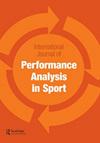奥运会和残奥运动中的绩效分析实践:教练和分析师经验的比较
IF 1.6
4区 教育学
Q1 Health Professions
International Journal of Performance Analysis in Sport
Pub Date : 2022-03-18
DOI:10.1080/24748668.2022.2054623
引用次数: 2
摘要
采用问卷调查的方法,对18名教练(平均绩效分析经验:8.3±4.8年)和23名绩效分析师(平均绩效分析经验:6.4±4.1年)在奥运会和残奥会应用环境中绩效分析交付方面的一致性进行了调查。就提供完整录像的重要性和必要性达成了明确的一致意见。大多数分析师(73.9%)经常或一直提供分析,而只有三分之一的教练认为这是必需的。教练们不仅同意教练理念是指导分析的主要因素,而且还强调训练目标、运动员的水平或年龄以及与运动员的讨论都是影响因素,这远远超过了分析师的认识。时间是影响沟通的一个潜在障碍,所有分析师都强调这是影响他们发挥作用的一个主要因素。大多数分析师(87%)试图在运动员表现后的一小时内,经常或一直向运动员提供反馈。教练们也表达了类似的理念,但他们更愿意在以后的时间里提供反馈。分析人员和教练应该利用这些发现来审查实践,确定实践中的差距,并突出发展领域。本文章由计算机程序翻译,如有差异,请以英文原文为准。
Performance analysis practice within Olympic and Paralympic sports: A comparison of coach and analyst experiences
ABSTRACT Concordance between 18 coaches (mean performance analysis experience: 8.3 ± 4.8 years) and 23 performance analysts (mean: 6.4 ± 4.1 years) regarding their performance analysis delivery within applied Olympic and Paralympic environments was investigated using survey-based methods. There was clear agreement on the provision, importance and need for full video. The majority of analysts (73.9%) provided profiling often or all of the time, whereas only one third of coaches felt that this was the required amount. Coaches not only agreed that coaching philosophy was the main factor directing analysis but also emphasised that training goals, level or age of athlete and discussions with athletes were influencers, far more than the analysts realised. A potential barrier for better communication was time, highlighted by all analysts as a major factor impacting their role. The majority of analysts (87%) attempted to provide feedback to athletes within one hour of performance, often or all the time. Coaches expressed a similar philosophy but were far more likely to want to provide feedback at later times. These findings should be utilised by analysts and coaches to review practice, identify gaps within practice and highlight areas for development.
求助全文
通过发布文献求助,成功后即可免费获取论文全文。
去求助
来源期刊

International Journal of Performance Analysis in Sport
SPORT SCIENCES-
CiteScore
4.70
自引率
4.80%
发文量
38
审稿时长
>12 weeks
期刊介绍:
The International Journal of Performance Analysis in Sport aims to present current original research into sports performance. In so doing, the journal contributes to our general knowledge of sports performance making findings available to a wide audience of academics and practitioners.
 求助内容:
求助内容: 应助结果提醒方式:
应助结果提醒方式:


